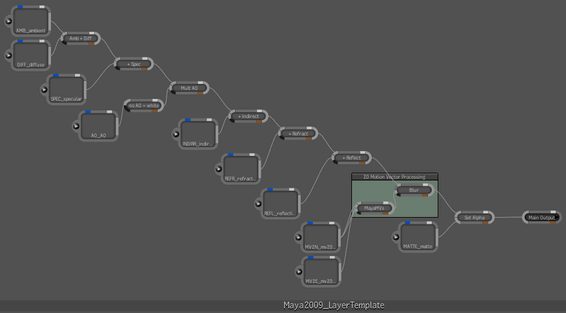There are three types of templates that you specify in the Pre-Compositing Import Options dialog box during import: layer, scene, and merge.
The layer template assembles passes from a single layer. This is the default template provided with Composite. For example, the following shows the default Maya 2011 layer template provided with Composite. Its link nodes have render pass anchors that match the default name of the standard render passes in Maya.

Because the layer template assembles passes from a single layer, the render layer template composition must contain link nodes with a render pass anchor on them—see Pre-Compositing Anchors. On render layer templates, the render passes are assembled to reflect the shaders network in the 3D application. The render layer template can be different on each layer. If no render layer template is specified, the default layer template for the given 3D application is used.
The name of the default template is based on the application name and its version, such as Maya2011_LayerTemplate.txcomposition. The script uses the template file that is closest to the version that the application used to generate the pre-comp file.
Default pre-compositing templates are located in:
The scene template stacks the layers using Blend & Comp nodes and assembles the layers in the same order as in the 3D scene. This template assembles layers in the scene for a given camera view, so the scene template composition must contain link nodes with a render layer anchor on them—see Pre-Compositing Anchors.The scene template can be different for each camera view. If no scene template is specified, the layers are stacked using Blend & Comp nodes and the layers are assembled in the same order and blend modes as in the 3D scene.
The Merge template assembles all passes of all layers, so the merged template composition must contain link nodes with both Render Pass and Render Layer anchors on them—see Pre-Compositing Anchors.